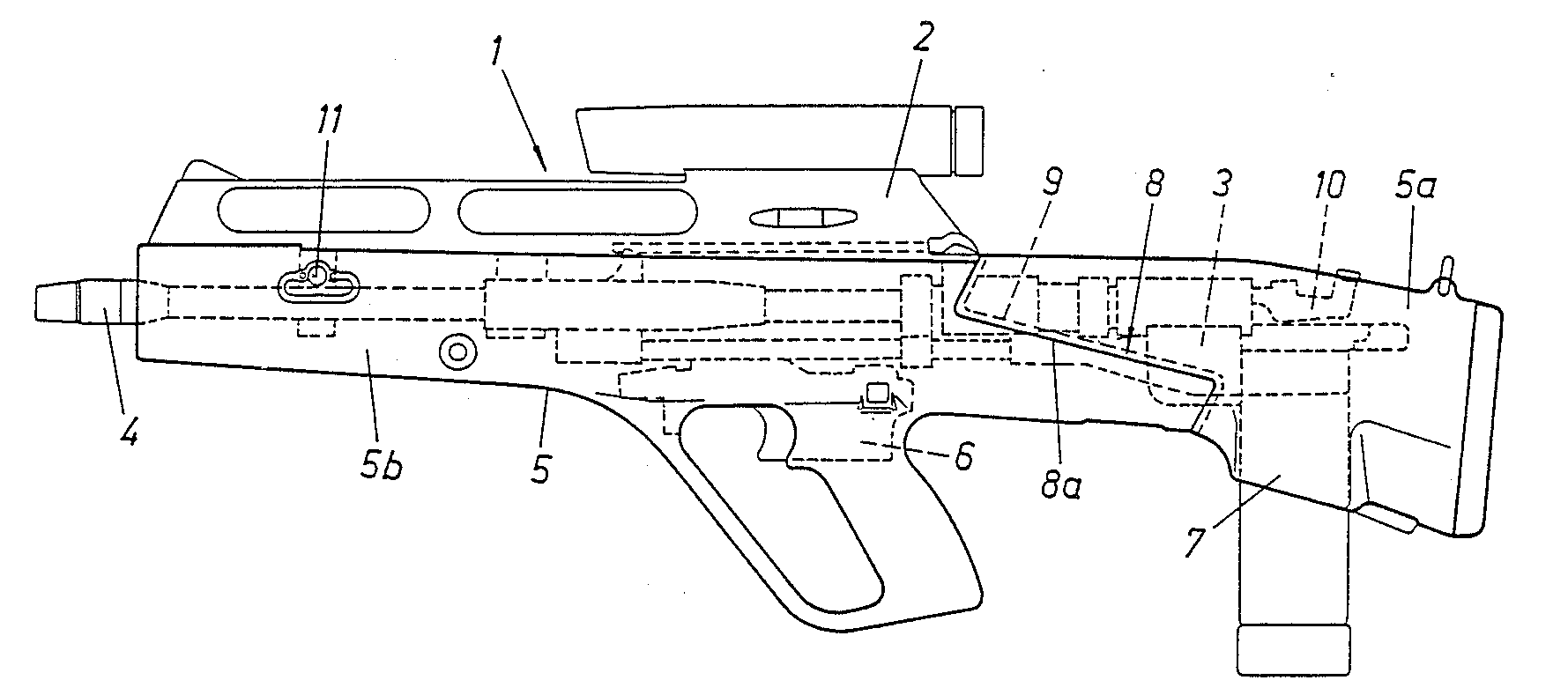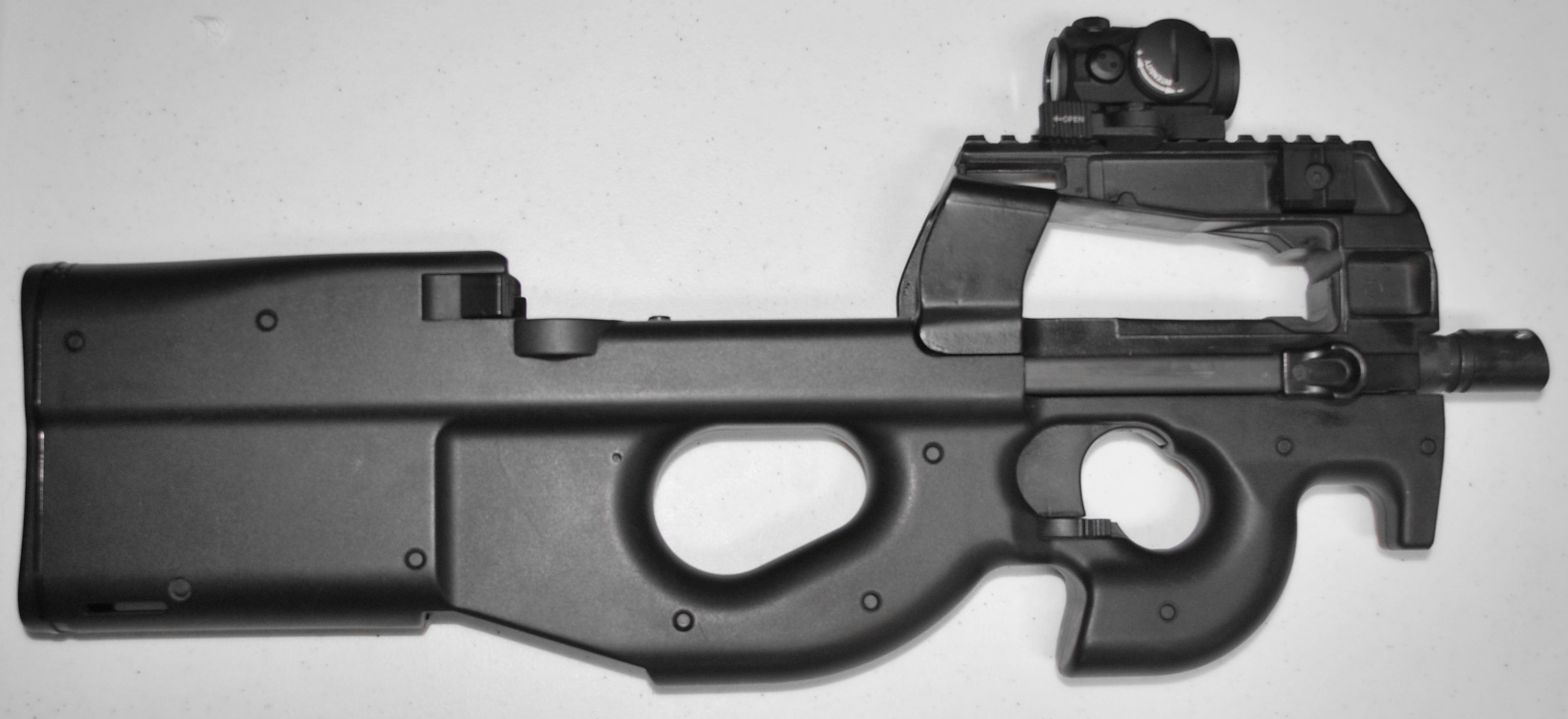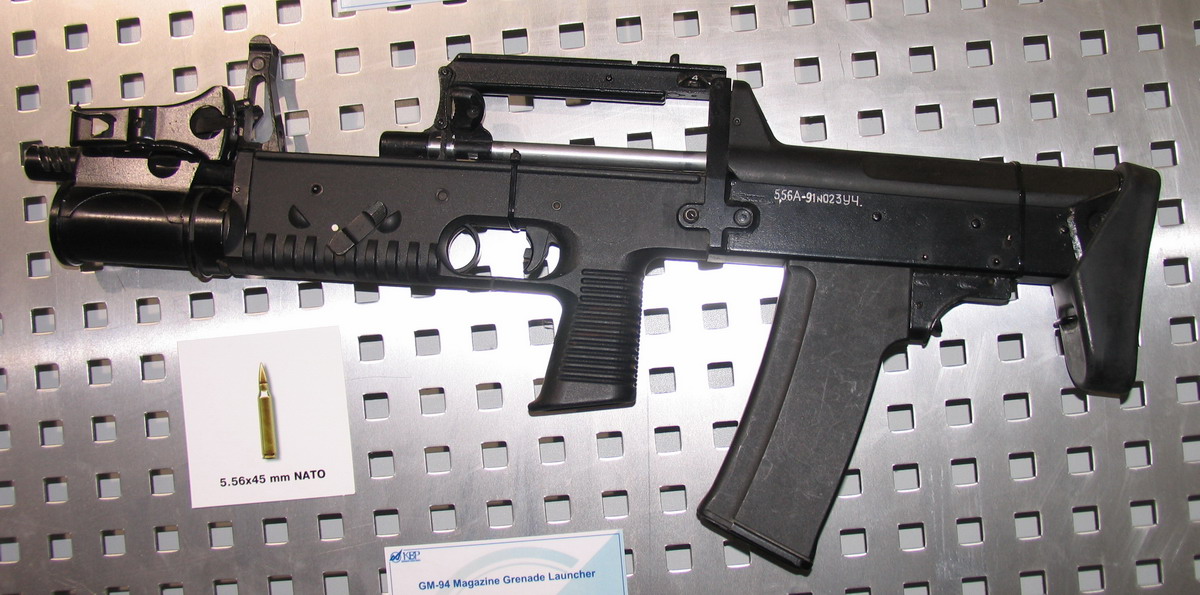|
Steyr ACR
The Steyr ACR was a prototype flechette-firing assault rifle built for the US Army's Advanced Combat Rifle program of 1989/90. Although the Steyr design proved effective, as did most of the weapons submitted, the entire ACR program ended with none of the entrants achieving performance 100% better than the M16A2, the baseline for a successful ACR weapon. Design The Steyr ACR has some superficial resemblance to the Steyr AUG, although it is rounder and the barrel is covered for almost its entire length, as opposed to the AUG where much of the barrel was exposed. Like the AUG the ACR is a bullpup design with the 24-round magazine located quite close to the buttstock of the gun. The stock was "split" from the magazine forward to a location just below the sights to open for cleaning. An optical sight was included as a standard feature. The Steyr employed a unique system to cycle through ammunition: instead of driving rounds forward into the chamber and being held in place by a lockin ... [...More Info...] [...Related Items...] OR: [Wikipedia] [Google] [Baidu] |
Austria
Austria, , bar, Östareich officially the Republic of Austria, is a country in the southern part of Central Europe, lying in the Eastern Alps. It is a federation of nine states, one of which is the capital, Vienna, the most populous city and state. A landlocked country, Austria is bordered by Germany to the northwest, the Czech Republic to the north, Slovakia to the northeast, Hungary to the east, Slovenia and Italy to the south, and Switzerland and Liechtenstein to the west. The country occupies an area of and has a population of 9 million. Austria emerged from the remnants of the Eastern and Hungarian March at the end of the first millennium. Originally a margraviate of Bavaria, it developed into a duchy of the Holy Roman Empire in 1156 and was later made an archduchy in 1453. In the 16th century, Vienna began serving as the empire's administrative capital and Austria thus became the heartland of the Habsburg monarchy. After the dissolution of the H ... [...More Info...] [...Related Items...] OR: [Wikipedia] [Google] [Baidu] |
Liquid Crystal Polymer
Liquid crystal polymers (LCPs) are polymers with the property of liquid crystal, usually containing aromatic rings as mesogens. Despite uncrosslinked LCPs, polymeric materials like liquid crystal Elastomer, elastomers (LCEs) and liquid crystal networks (LCNs) can exhibit liquid crystallinity as well. They are both crosslinked LCPs but have different cross link density. They are widely used in the digital display market. In addition, LCPs have unique properties like thermal actuation, anisotropic swelling, and soft elasticity. Therefore, they can be good actuators and sensors. One of the most famous and classical applications for LCPs is Kevlar, a strong but light fiber with wide applications including bulletproof vests. Background Liquid crystallinity in polymers may occur either by dissolving a polymer in a solvent (lyotropic liquid-crystal polymers) or by heating a polymer above its glass or melting transition point (thermotropic liquid-crystal polymers). Liquid-crystal ... [...More Info...] [...Related Items...] OR: [Wikipedia] [Google] [Baidu] |
Bullpup Rifles
A bullpup firearm is one with its firing grip located in front of the breech of the weapon, instead of behind it. This creates a weapon with a shorter overall length for a given barrel length, and one that is often lighter, more compact, concealable and more maneuverable than a conventionally configured firearm. Where it is desirable for troops to be issued a more compact weapon, the use of a bullpup configuration allows for barrel length to be retained, thus preserving muzzle velocity, range and ballistic effectiveness. The bullpup concept was first tested militarily in 1901 with the British Thorneycroft carbine, but it was not until the Cold War that more successful designs and improvements led to wider adoption. In 1977, the Austrian Army became the first military force in the world to adopt a bullpup rifle, the Steyr AUG, as a principal combat weapon. Since then the militaries in many countries have followed suit with other bullpup designs, such as the Chinese QBZ ... [...More Info...] [...Related Items...] OR: [Wikipedia] [Google] [Baidu] |
Assault Rifles Of Austria
An assault is the act of committing physical harm or unwanted physical contact upon a person or, in some specific legal definitions, a threat or attempt to commit such an action. It is both a crime and a tort and, therefore, may result in criminal prosecution, civil liability, or both. Generally, the common law definition is the same in criminal and tort law. Traditionally, common law legal systems have separate definitions for assault and battery. When this distinction is observed, battery refers to the actual bodily contact, whereas assault refers to a credible threat or attempt to cause battery. Some jurisdictions combined the two offences into a single crime called "assault and battery", which then became widely referred to as "assault". The result is that in many of these jurisdictions, assault has taken on a definition that is more in line with the traditional definition of battery. The legal systems of civil law and Scots law have never distinguished assault from ba ... [...More Info...] [...Related Items...] OR: [Wikipedia] [Google] [Baidu] |
List Of Bullpup Firearms
The following is a list of firearms designed in a bullpup (i.e., action behind firecontrol/trigger group) configuration. References {{Bullpup Firearms, Rifles=Pindad SS2 Bullpup Bullpup firearms A bullpup firearm is one with its firing grip located in front of the breech of the weapon, instead of behind it. This creates a weapon with a shorter overall length for a given barrel length, and one that is often lighter, more compact, con ... * ... [...More Info...] [...Related Items...] OR: [Wikipedia] [Google] [Baidu] |
Polymer-cased Ammunition
Polymer-cased ammunition (PCA) is firearm ammunition (cartridge) with casings made from synthetic polymer instead of the typical metallic casing. PCA is considered a new alternative that potentially reduces production cost and weight for long guns and handguns. Origin The first references to the possible use of polymers in the manufacture of casings come from the early 1950s. One of the earliest is the patent filed by Jack W. Roske in 1950 and the idea was to use a metal cup joined with a polymer shell "that will be converted to gas during the firing phase to assist in propelling the projectile and thereby permit reduction in the use of the propelling powder charge". Examples * The majority of commonly found shotgun shell hulls are constructed of polymer with metal only found on the lower or rim portions of the shells. * The Steyr ACR was a notable user of polymer cased ammunition. * The US Army ARDEC developed a 5.56mm Telescoped ammunition for its LSAT program. * The Assist ... [...More Info...] [...Related Items...] OR: [Wikipedia] [Google] [Baidu] |
Steyr IWS 2000
The Steyr IWS 2000 is an Austrian single-shot bolt-action anti-materiel rifle produced by Steyr Mannlicher. IWS stands for Infantry Weapon System. Like many anti-tank rifles, it is actually a smoothbore weapon and not a true rifle. This can help accelerate projectiles and increase ballistic effectiveness, but the lack of rifling imparting inertial stability requires the projectile to have stabilizing fins. It is chambered in a 15.2×169 mm armor-piercing fin-stabilized discarding-sabot cartridge, and is the first man-portable rifle to use this type of ammunition. The first variant of the weapon was the proposed AMR 5075 (AMR standing for anti-materiel rifle). It was to fire the same type of ammunition as the IWS 2000 and to use a 5-round detachable box magazine. However, that version did not pass the proposal stage. Design The weapon is based on a long recoil mechanism. This mechanism, usually found in shotguns, helps manage the heavy recoil forces of the 15.2 mm Steyr APFS ... [...More Info...] [...Related Items...] OR: [Wikipedia] [Google] [Baidu] |
Steyr AMR 5075
Steyr (; Central Bavarian: ''Steia'') is a statutory city, located in the Austrian federal state of Upper Austria. It is the administrative capital, though not part of Steyr-Land District. Steyr is Austria's 12th most populated town and the 3rd largest city in Upper Austria. The city has a long history as a manufacturing center and has given its name to several manufacturers headquartered there, such as the former Steyr-Daimler-Puch conglomerate and its successor Steyr Motors. Geography The city is situated in the Traunviertel region, with the two rivers Steyr and Enns flowing through it and meeting near the town centre beneath Lamberg Castle and St Michael's Church. This prominent location has made it prone to severe flooding through the centuries until the present, one of the worst cases being recently in August 2002. To the south of the town rises a series of hills that climb in altitude and stretch out to the Upper Austrian Prealps. To the north, the hills roll downwar ... [...More Info...] [...Related Items...] OR: [Wikipedia] [Google] [Baidu] |
Special Purpose Individual Weapon
The Special Purpose Individual Weapon (SPIW) was a long-running United States Army program to develop, in part, a workable flechette-firing "rifle", though other concepts were also involved. The concepts continued to be tested under the Future Rifle Program and again in the 1980s under the Advanced Combat Rifle program, but neither program resulted in a system useful enough to warrant replacing the M16. Project SALVO The idea of a flechette-firing individual weapon started in earnest during the Army's Project SALVO. SALVO had earlier concluded that a small weapon with a high rate of fire would be considerably deadlier than the large "full power" weapons being developed in the 1950s, and followed several lines of investigation to find the best way to provide high firing rates. SALVO had a small number of "duplex load" weapons developed, where two bullets were stacked, while Springfield Armory and Olin/Winchester both entered multiple barrel firearms. Even before the SALVO tests, ... [...More Info...] [...Related Items...] OR: [Wikipedia] [Google] [Baidu] |
Heckler & Koch G11
The Heckler & Koch G11 is a non-production prototype assault rifle developed from the late 1960s–1980s by ''Gesellschaft für Hülsenlose Gewehrsysteme'' (GSHG) (German for "Association for Caseless Rifle Systems"), a conglomeration of companies headed by firearm manufacturer Heckler & Koch (mechanical engineering and weapon design), Dynamit Nobel (propellant composition and projectile design), and Hensoldt Wetzlar (target identification and optic systems). The rifle is noted for its use of caseless ammunition. It was primarily a project of West Germany, though it was of significance to the other NATO countries as well. In particular, versions of the G11 were included in the U.S. Advanced Combat Rifle program. In 1990, H&K finished the development of the G11, intended for the ''Bundeswehr'' and other NATO partners. Although the weapon was a technical success, it never entered full production due to the political changes of German reunification and lack of procurement contra ... [...More Info...] [...Related Items...] OR: [Wikipedia] [Google] [Baidu] |
Colt ACR
The Colt ACR was Colt's entry in the U.S. DoD Advanced Combat Rifle program, which concluded with the result that none of the entrants achieved enough of an improvement over the M16 to be worth the cost. The Colt ACR was not a total loss, however; the scope went on to be offered by Elcan as the C79, a version of which was eventually adopted as the M145 Machine Gun Optic used on a number of firearms, especially those from Diemaco (now Colt Canada). Overview The main differences of the Colt ACR and the M16A2 is the distinctive furniture. The handguard included a heat-resistant inner lining, vent holes for lightening and air cooling with a thickened ring around the front end to act as a handstop. This was topped with an elevated sight track rib with a white stripe to improve fast target acquisition. The pistol grip was longer and of a different profile than a traditional M16A2, and the rifle featured ambidextrous fire control selectors, removable scope and a streamlined 6 posit ... [...More Info...] [...Related Items...] OR: [Wikipedia] [Google] [Baidu] |
AAI ACR
The AAI ACR was a prototype flechette-firing assault rifle built for the US Army's Advanced Combat Rifle program of 1989/90. Although the AAI design proved effective, as did most of the weapons submitted, the entire ACR program ended with none of the entrants achieving performance 100% better than the M16A2, the baseline for a successful ACR weapon. Design Based on AAI's SFR/XM19 rifle developed as part of the SPIW program, the AAI ACR was externally one of the more conventional entrants to the ACR program. A closed bolt, gas operated, full stocked, magazine fed, conventionally laid out rifle. The 1990 ACR Program Summary report describes the operation system as: "…incorporate an 'entrapped gas' operating system. Gun gases enter a cylinder, drive a piston to power the system, and prevent any leakage of propellant gases and residues into the other mechanism parts." Other contemporary sources describe it as innovative, but how it differs from traditional Long or Short stroke pi ... [...More Info...] [...Related Items...] OR: [Wikipedia] [Google] [Baidu] |








